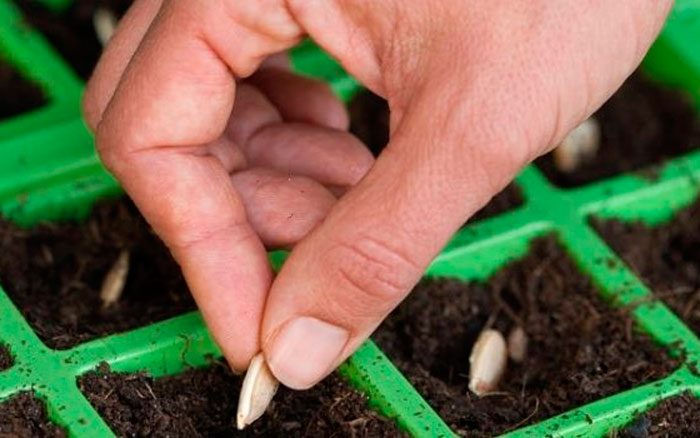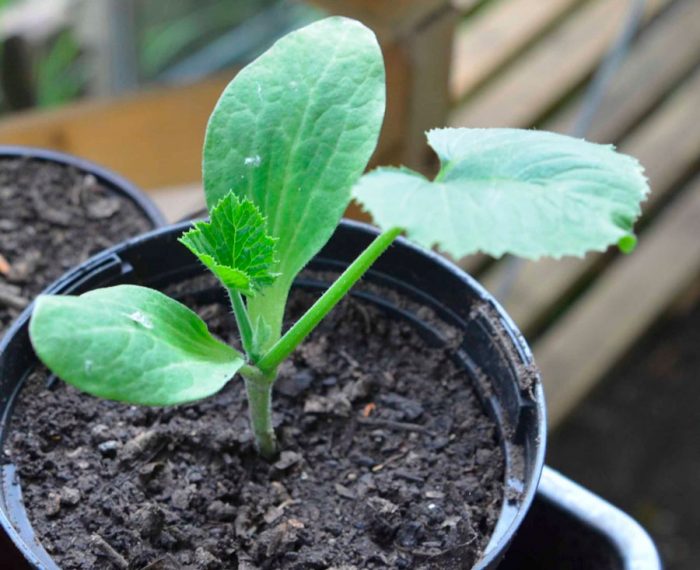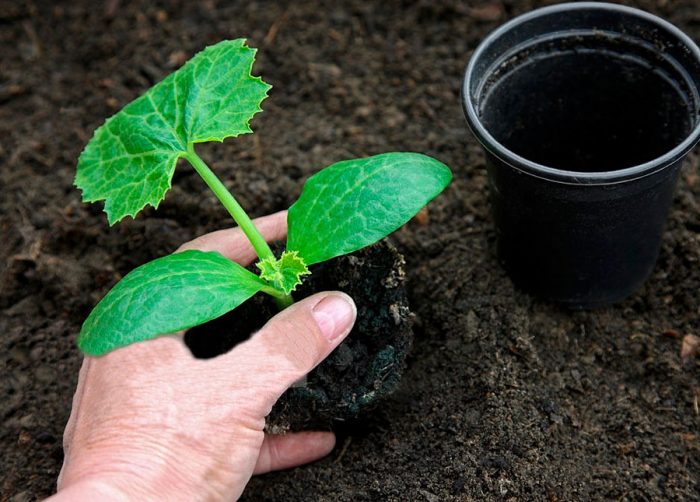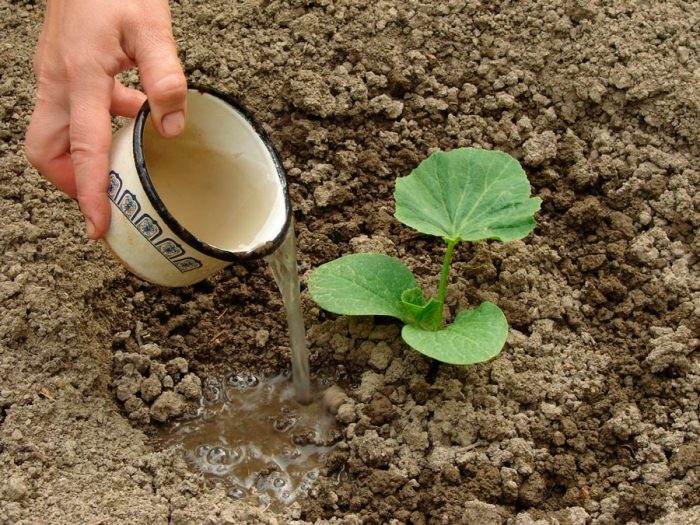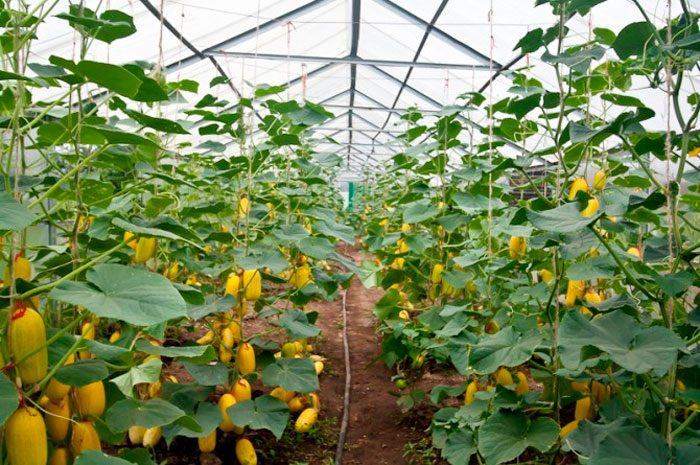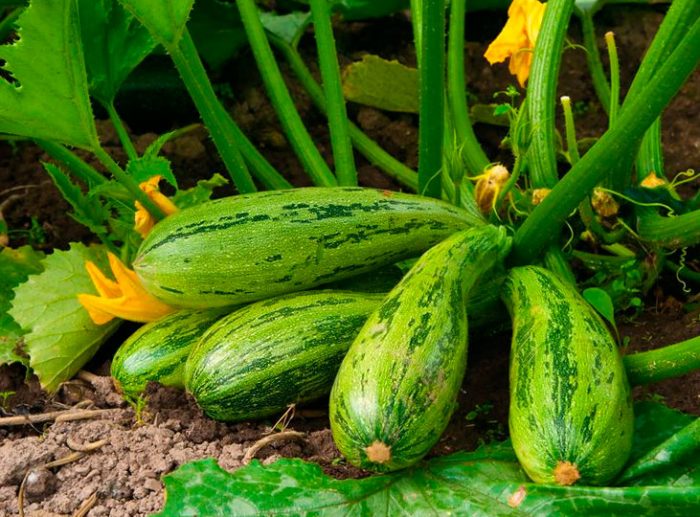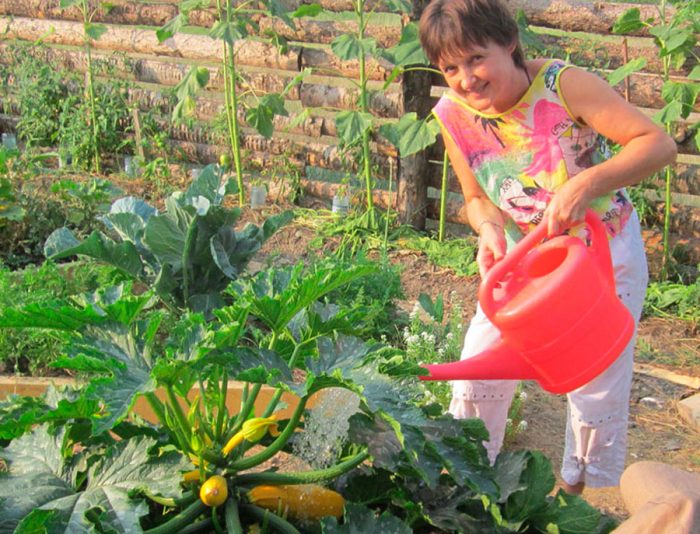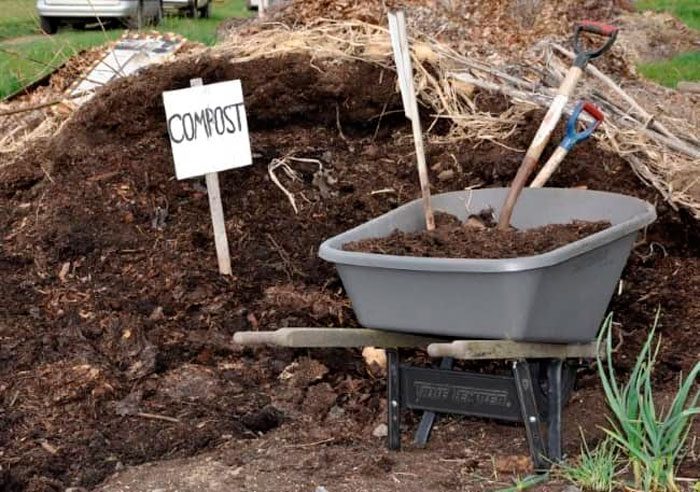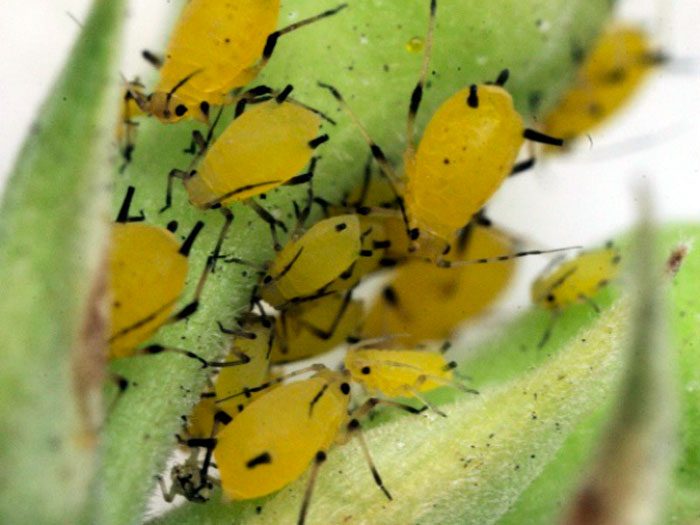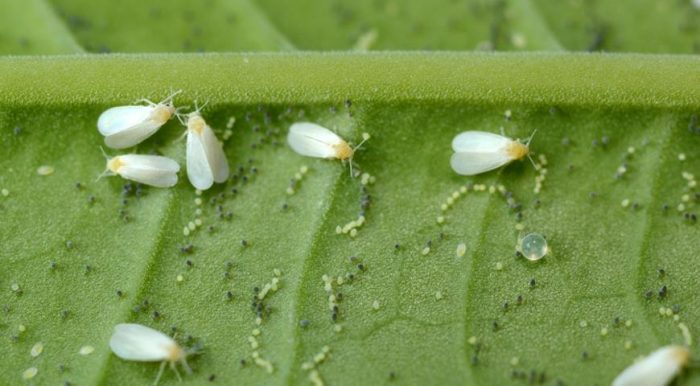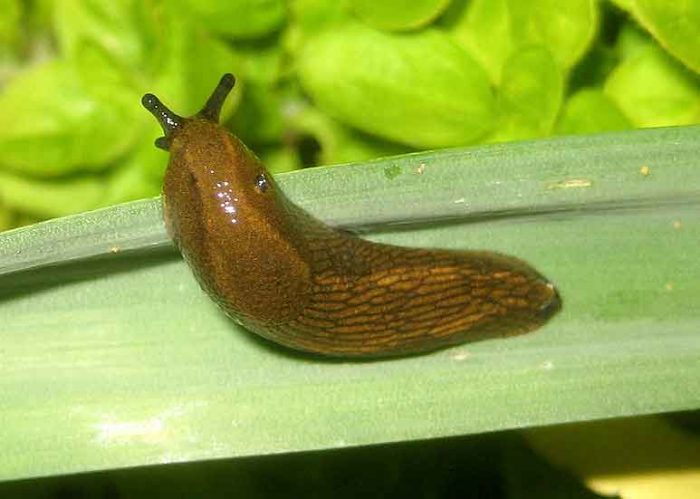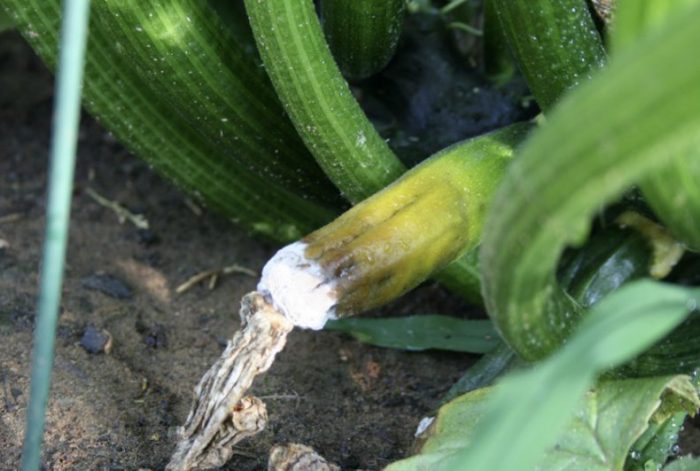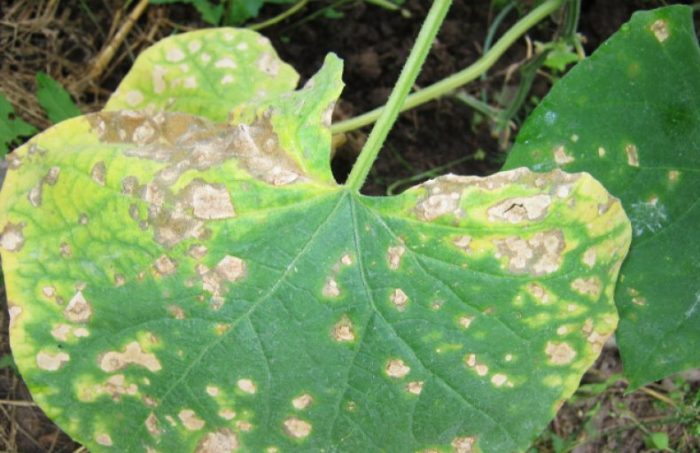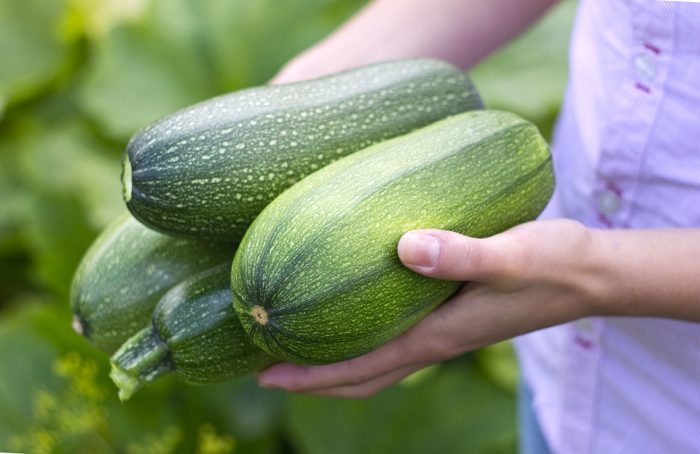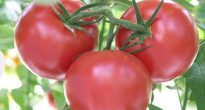Zucchini (Cucurbita pepo var. Giraumontia) is a bushy variety of hard-bore pumpkin, this plant is a member of the Pumpkin family. Fruits (pumpkins) have an oblong shape, and they can be colored green, greenish-black, yellow or white. The pulp inside the fruit is quite tender. Zucchini is fried, pickled, stewed, canned, and also eaten raw. The homeland of such a vegetable culture is the Oaxaca Valley in Mexico; in the 16th century, zucchini and other plants unusual for the Old World were brought to Europe from there. At first, zucchini was cultivated exclusively in greenhouses, as the rarest plant. It wasn't until the 18th century that unripe pumpkins were used for cooking. Since then, this plant has gained great popularity, since its fruits are low in calories, easily digestible and have high taste. They are widely used in European cuisine, as well as in dietary nutrition. Hot dishes, salads and preparations for the winter are prepared from them, and it is also recommended to include zucchini in the diet of patients who are recovering, as well as children.
Content
Zucchini features
Zucchini is a diminutive of the Ukrainian word "tavern", which means "pumpkin". Such a herbaceous plant is an annual and has a developed root system, reaching 150 cm in diameter, the central root can penetrate into the deep layers of the soil (150-170 cm deep), however, the main part of the roots is located close to the surface of the site (at a depth of no more than 40 centimeters ). On the shoots, there are large five-lobed leaf plates on poorly pubescent petioles. A rather powerful bush is formed from them, on which many female and male flowers grow. This high-yielding plant has a short growing season. The fruit, which is a pumpkin, can be round, curved or elongated, they are colored in various shades of green, and also in white and yellow (sometimes striped). Zucchini grows and ripens very quickly and in relatively large quantities. 2 or more varieties of zucchini cannot be grown on the same plot, since this crop is cross-pollinated.
Growing zucchini from seeds
Sowing
The plus of growing zucchini through seedlings is that mature fruits can be removed from the bush much earlier than when sowing seeds in open soil. But it should be borne in mind that pumpkins collected from such bushes are not intended for long-term storage, in this regard, after harvesting, they should be processed or used as food as soon as possible. If you are going to store fruits for a long time, then it is recommended to sow seeds directly into open soil. This is done from the beginning of May to the first days of June, while the soil on the site should warm up to a depth of 80–100 mm to a temperature of 12 to 13 degrees. Such seeds need pre-sowing preparation, and there are several ways:
- seeds for 1-2 days are immersed in a liter of lukewarm water, in which 1 tbsp. l. wood ash (ash can be replaced with Zircon, potassium humate, trace elements or Epin);
- seeds are heated in the sun for a week;
- the seeds are kept for 24 hours in lukewarm water, after which they are wrapped in a damp cloth and kept warm for three or four days (from 22 to 25 degrees).
However, the hardening method has the greatest reliability in the preparation of seed. To do this, the seeds are alternately removed in the refrigerator on a shelf for vegetables, where they should stay from 14 to 16 hours, then they are kept at room temperature for 8 to 10 hours.
The site for planting this culture should be prepared in advance. To do this, in the autumn, they dig it to the depth of a shovel bayonet, adding 50 to 60 grams of superphosphate, 10 to 15 kilograms of compost and one handful of wood ash per 1 square meter of land to the soil. In spring, the surface of the site must be leveled, after which planting pits are made on it in rows according to the scheme of 70x50 centimeters, their depth should be about 10 centimeters. It should be noted that there should be no more than three holes on 1 square meter of the bed. Pour 1 tbsp into each hole. l. humus and wood ash, after which the soil is mixed well with poured fertilizers and spilled with water. 2 or 3 seeds are placed in each hole, after which they must be covered with soil. If the soil on the site is heavy, then the seeds need to be buried no more than 30-50 mm, and if it is light, then by 50-70 mm. If several seedlings appear in the hole, then it will be necessary to plant the extra ones, leaving only one plant.
Growing marrow seedlings
When growing zucchini through seedlings, it will be possible to get fruits much faster. Before sowing on seedlings, the seed should be prepared in the same way as for sowing in open soil. You need to sow only those seeds that are well swollen, they should have tiny sprouts. The sowing substrate should be alkaline or neutral, it should include humus (20%), peat soil (50%), sawdust (10%) and sod land (20%). If the soil mixture is too acidic, then chalk or wood ash must be added to it. Such seedlings grow well in a ready-made soil mixture called "Exo", which can be purchased at a specialized store.
Take peat pots that are 80–100 mm across and fill them with the prepared substrate. For disinfection, the soil mixture is spilled with a weak solution of manganese potassium or with hot water. Then the seeds are sown, they need to be buried in the substrate by 20 mm. After sowing, the pots must be covered with glass or foil on top. Sowing seeds for seedlings is carried out 20-30 days before they are transplanted into open soil. Depending on the climate in a particular region, sowing can be carried out both in the first days of April and in early May. Before the seedlings appear, the crops will need to provide a temperature of about 20-22 degrees.And after the appearance of plants from the containers, it will be necessary to remove the shelter, after which they are transferred to a well-lit (sunlight must be diffused), cool place. So, in the daytime the air temperature should be about 15-18 degrees, while at night - it should not be lower than 13-15 degrees. For this, the plant can be transferred to a loggia or a glazed balcony. After 7 days, the zucchini are again transferred to the heat (temperature from 20 to 22 degrees). Thanks to this, the plants will not stretch.
Seedlings should be provided with timely watering; for this, well-settled water at room temperature is used. At the same time, remember that the top layer of the substrate should not dry out. Such seedlings will need at least two dressings, while using both organic matter and mineral fertilizers. After 1–1.5 weeks after the seedlings appear, they need to be fed with a mullein solution (1:10), while 50 ml must be poured into each pot. You can replace organic matter with a solution of mineral fertilizer (5 to 7 grams of superphosphate and 2-3 grams of urea are taken for 1 liter of water), under 1 bush, pour ½ tbsp. mixtures. After another 7 days, the zucchini are fed with a solution of nitrophoska (1 tsp per 1 liter of water), while 1 tbsp is poured under 1 bush. mixtures. When choosing fertilizers for such a crop, it must be borne in mind that it does not tolerate chlorine.
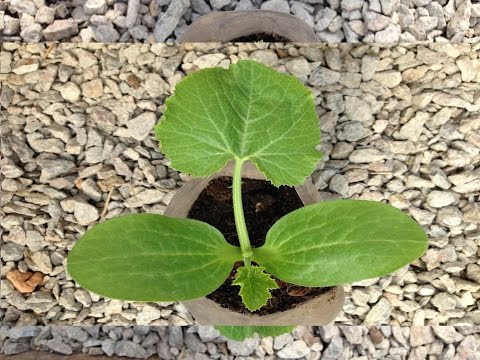

Watch this video on YouTube
Picking
Zucchini seedlings react extremely negatively to picking, therefore it is recommended to sow it immediately in individual containers. If several plants sprout in one container at once, jig the extra zucchini, leaving only one in the pot. This process can be conditionally called picking.
Planting zucchini in open ground
What time to plant
Zucchini seedlings should be planted in open soil approximately 4 weeks after the seedlings appear. As a rule, disembarkation occurs in the last days of May or the first days of June, after the threat of return spring frosts has been left behind.
Suitable soil
A suitable site for planting this crop should be well lit, protected from gusts of wind, located on the southwestern or southern side of the garden, while the groundwater should lie deep enough. And the soil should be slightly alkaline or neutral. You can not grow zucchini for at least three years in those areas where representatives of the Pumpkin family were cultivated (for example, cucumbers, pumpkin, zucchini or squash), otherwise there is a high probability that the bushes will infect diseases that are typical for pumpkin seeds. The best predecessors for such a plant are: peas, tomatoes, parsley, lettuce, cabbage, onions, garlic, radishes, carrots, potatoes and green manures.
The landing site should be prepared in advance. To do this, in the autumn, he will need to dig to a depth of about 0.3 m, while 20 grams of potassium sulfate, 5 kilograms of humus or compost and 30 grams of superphosphate per 1 square meter must be added to the soil. In spring, the soil on the site should be loosened, while ammonium nitrate (15 grams per 1 square meter of the site) is added to it to a depth of about 10 centimeters. Then the surface of the site should be leveled.
Rules for planting seedlings in open ground
On the site, planting holes should be made in such a way that there are no more than 3 pieces per 1 square meter of the garden. Row spacing should be between 100 and 150 centimeters. A small amount of humus and wood ash must be poured into each hole; fertilizers must be mixed with the soil. After that, a plant is planted in the hole, which is taken together with an earthen lump, while it is necessary to deepen it in cotyledonous leaf plates, and fill the voids in the hole with earth.The soil must be compacted, after which the zucchini is watered abundantly. It is necessary to plant seedlings in open soil in cloudy and warm weather. If there is a danger of recurrent frost, each plant will need to be covered with a cut plastic bottle, or metal arcs are installed over the bushes, over which a plastic film is stretched. After the zucchini are planted in the garden, the next day you will need to loosen its surface.
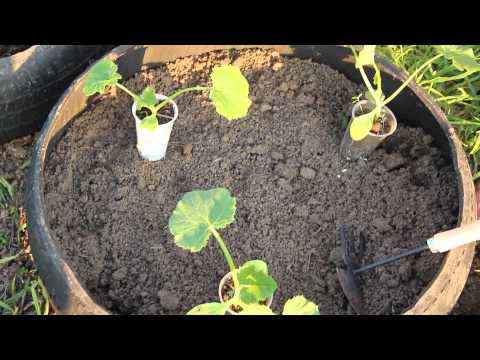

Watch this video on YouTube
Growing zucchini in a greenhouse
In a film greenhouse, planting of marrow seedlings should be done in cloudy weather or in the afternoon. Planting is carried out 15–20 days earlier than transplanting seedlings into open soil, in this regard, and sowing seeds in pots must be done earlier by the same number of days. On the garden bed in the greenhouse, holes should be made in a square or round shape, in diameter they should reach half a meter, while their depth should be about 0.3 m, and the distance between the holes should be from 0.7 to 0.8 m. In each hole add 30 grams of potassium sulfate, 500 grams of peat compost and 50 grams of superphosphate. After the pits are shed, seedlings should be planted in them, after which the pits are filled with soil, and the plants are re-watered. In the greenhouse, you need to maintain a certain temperature regime, so, during the day it should be about 23-25 degrees, and at night - from 14 to 15 degrees. The soil temperature should not be less than 18 degrees, and the optimal air humidity should be from 60 to 70 percent.
In the greenhouse, plants should be properly cared for, for this they need to be ventilated in a timely manner and watered moderately, as well as loosen the soil surface in time, remove weeds and feed them. In the event that overly active foliage growth is observed in the bushes, then because of this, the air humidity in the greenhouse can increase significantly, as a result of which the ovaries may be dropped in the plants. In order to prevent this, in the middle or lower part of the stem, it is necessary to remove from 2 to 4 leaf plates, and in the greenhouse it is necessary to systematically arrange ventilation.
Zucchini care
It is quite simple to care for zucchini grown in open ground, for this they need to be watered in a timely manner, after which the soil surface between the rows is loosened, and all weeds are removed. Still, such plants need to be fed on time and protected from various pests and diseases. If the bushes have begun to bloom, and the bees are not visible on the site, then pollination will have to be done manually. To do this, cut off the male flower (it does not have an ovary on the back) and tear off all the petals from it, after which the pistil should be exposed, which should be used to mark the stamens in the opened female flowers. One male flower is enough for pollination of 2 or 3 female flowers. It is also important to remove grown fruits in a timely manner.
How to water
The bushes should be watered in the evening, using water that has been heated in the sun during the day. On hot days, before the foliage closes, the zucchini must be watered every day. When the foliage closes and covers the surface of the garden, it will be necessary to water the bushes less often, as a rule, once every 5 or 6 days if it is cool and cloudy outside, and in hot weather - once every two or three days. When watering, water is poured carefully under the root, and in order to protect ripening fruits from rotting, a waterproof material is placed under them (for example, a piece of slate or a board). If in hot weather the foliage on the bushes becomes sluggish, then in the evening it should be watered through a nozzle with small holes.
Fertilizer
This crop prefers organic fertilizers. For seedlings transplanted into open soil, you can prepare a herbal infusion. To do this, you need to fill a barrel located on the street, almost to the top with weeds, and then pour water into it.Stir the contents of the barrel every day. The infusion will be ready after 7 days, it is filtered and combined with water in a ratio of 1: 8. After half a month after planting on the garden, the seedlings need to be watered with this infusion, while trying not to get it on the shoots or foliage. After 7 days, the seedlings are fed again with this infusion. Some gardeners feed zucchini alternately with herbal infusion and slurry. To prepare it, it is necessary to combine manure with water in a ratio of 1:10, the mixture should be infused in the sun for three days. With the finished infusion, you need to carefully water the soil around the root of the bush, while it should not get on the shoots or foliage of the squash. After the formation of ovaries begins, it is recommended to feed the plants again, for this use the following nutrient mixture: 1 bucket of manure or herbal infusion must be mixed with 1 tbsp. sifted wood ash and 1 tbsp. l. double superphosphate. Experts advise, before you start feeding the bushes, be sure to water the garden.
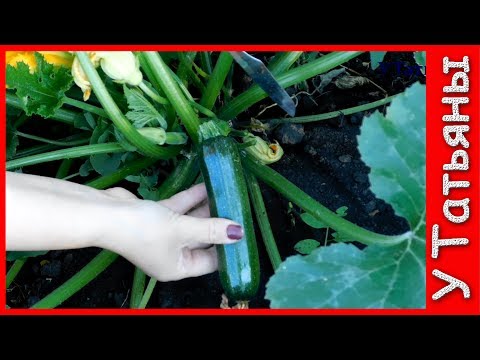

Watch this video on YouTube
Treatment
In order to prevent zucchini from becoming infected with any diseases and to protect them from harmful insects, it is necessary to resort to preventive treatments. To do this, 7 days after planting the seedlings in open soil, the bushes need to be sprayed with a solution of Karbofos, which will protect them from harmful insects, and they are also treated with a solution of copper oxychloride or Bordeaux liquid (1%), this will help protect the squash from fungal diseases. In addition, in the autumn, when the crop and plant residues are harvested from the site, he will need a deep digging, and he should also be prepared for planting the next crop, while not forgetting about the rules of crop rotation.
Diseases and pests of zucchini with photos
Even if the zucchini is properly looked after and all preventive treatments are carried out in a timely manner, as well as the rules of crop rotation and agricultural technology, these plants can still get sick. To begin the timely treatment of such a culture, you need to know the symptoms of diseases, as well as what harmful insects can settle on it.
Pests
Most often whiteflies and aphids settle on the bushes, and slugs can also harm them.
Melon aphid
If the weather is warm and humid, then there is a high probability that melon aphids will settle on the bushes. This pest feeds on plant sap, sucking it from any part of the bush located above the ground. As a result of the vital activity of aphids, foliage, ovaries, shoots and flowers are damaged. You can fight such insects with folk remedies, for this they use a solution of liquid dishwashing detergent or soap (for 1 bucket of water 300 grams), you will need to process the bushes 3 times. If such a treatment turns out to be ineffective, then the bushes will need to be sprayed with insecticidal preparations, for example: Phosphamide, Metaphos, Karbofos or Decis, but it is recommended to resort to this method of processing only in extreme cases.
Whiteflies
Whiteflies can seriously harm garden crops. In the second half of the summer period, the number of these pests is highest. They settle on the seamy surface of the sheet plates. As a result of their vital activity, sticky sugary secretions remain on the surface of the plant, on which a sooty fungus actively multiplies, due to which black marks form on the bush, leading to wilting of the foliage. The simplest way to combat whiteflies is to wash them off the bushes with a stream of water, then it is imperative to loosen the soil surface around the plant to a depth of about 20 mm.If the pests remain, then the plants will need to be sprayed with a solution of the insecticidal preparation Commander (1 gram of water for 1 bucket of water, this amount is enough to process 100 square meters of land). Processing should be done only after the crop has been harvested.
Slugs
If slugs have settled on the bushes, then they will need to be collected by hand. If there is an invasion of gastropods, then bait will have to be placed on the site. For this, bowls are placed in several places, which are filled with dark beer, after a while the baits are checked and the pests gathered around them are collected.
Diseases
The greatest danger to zucchini is bacteriosis, powdery mildew, root and white rot, anthracnose and black mold.
Powdery mildew
Powdery mildew affects the aerial parts of the bush, the surface of which is covered with a loose bloom of white-gray color. As the disease progresses, it turns brown, while the foliage covered with bloom begins to dry, and the affected fruits stop growing and their deformation is observed. The most active development of this disease is observed with sharp changes in temperature and humidity. As soon as the symptoms of such a disease are noticed, the bushes will need to be sprayed with a ten percent solution of a fungicidal drug (Baylon or Topsin). If there is such a need, then after half a month, re-processing is carried out.
Black mold
If zucchini are affected by black mold, then rusty specks of a round or angular shape are formed on the surface of their leaf plates. As the disease progresses, a dark bloom forms on the bush, which contains spores of the fungus. The foliage tissue, which is covered with specks, dries up and spills out, as a result of which holes appear on the plate. Shrinking and cessation of growth of pumpkins is observed. Diseased bushes should be removed from the soil as soon as possible and destroyed. After all the fruits have been collected, the site must be thoroughly cleaned of plant residues.
Bacteriosis
Bacteriosis is an infectious disease. In an infected plant, oily specks appear on the foliage, which eventually turn darker in color. Where such spots are located, a violation of the integrity of the leaves is observed. Ulcers and watery spots appear on the surface of the pumpkins. The disease develops most actively in warm and humid weather. Sick zucchini should be sprayed with a solution of Bordeaux mixture (1%).
White rot (sclerotinia)
If the bush is affected by sclerotonia (white rot), then its aerial parts are covered with mycelium, which is a dense bloom of white color. The plant tissue under such a bloom softens and becomes slippery, and as the disease develops, hard black bumps appear in these areas, and the foliage dries up and the entire bush withers. Bushes in dense plantings are most often affected at a time when the weather is wet and cold. It is recommended that the affected bushes be removed from the soil and destroyed as soon as possible. At the same time, spraying diseased plants with a fungicide solution is an ineffective procedure.
Root rot
If the bush is affected by root rot, then its lower leaf plates begin to dry out, the fruits turn yellow, and the stems are brown, while in the lower part they become similar to a washcloth. Most often, this disease develops when planting seedlings in cold soil, watering zucchini with cold water, and also as a result of excessively abundant dressing. To cure plants, you need to adhere to the rules of caring for them, and also spray them with a remedy containing copper.
Anthracnose
With anthracnose, rounded specks of brown-yellow color appear on the leaf plates. After drying, the fabric on the foliage spills out, and holes form on it. All aerial parts of the vegetable marrow are affected, while the bushes dry up and the foliage curls.Plants are most often affected by this disease in hot and damp weather. The affected bushes must be sprayed with a solution of Bordeaux mixture (1%), or they can be pollinated with ground sulfur (1.5–3 grams are taken per 1 square meter of the plot).
Collection and storage of zucchini
The collection of zucchini fruits is carried out as they ripen. So, after 6-8 weeks after sowing the seeds, the first zucchini will have to ripen for eating. As a rule, they are harvested by unripe greens, the length of which should be from 15 to 25 centimeters, while the seeds inside the pumpkin should be tender and small. Picking unripe fruits on a regular basis will speed up the growth of new pumpkins. But if you need zucchini that can be stored for a long time, then harvest them only after the pumpkins are fully ripe and their rind becomes thick and tough. For harvesting zucchini, a sharp knife or pruner is used, while the cut is made along the stalk.
Young fruits plucked for food or for the preparation of winter preparations should be cut directly at the base of the stalk. And those zucchini that are intended for longer storage should be removed with a long stalk, while the cut on it should be even. The fact is that if the place of the cut is shaggy, then this will lead to rapid damage to the stalk, which can cause the fruit to rot. Young fruits of milk ripeness can be stored for about 15 days in the refrigerator at a temperature of 0 to 2 degrees, after which they become coarse, wilting or decay. Ripe fruits are stored in a cool, well-ventilated and dry room, where they can lie for about 5 months. The cellar is not suitable for storing zucchini, because, as a rule, there is a rather high air humidity in it, due to which the development of putrefactive processes is activated, while those fruits on the surface of which are damaged most quickly rot. The fruits should be placed in a box, the bottom of which should be covered with coniferous sawdust or straw, while the pumpkins should not touch each other. To keep the zucchini for a very long time, their stalk must be immersed in straightened paraffin, and then let it dry. If you don't have a special room for storing such a vegetable, then place it in the apartment, choosing a dark and dry place for this, for example, they can be placed near the door leading to the balcony, or put under the bed. Such a vegetable is rather well stored on a refrigerator shelf intended for vegetables; it must first be placed in a polyethylene bag with several holes. If everything is done correctly, then the zucchini can lie until new ones grow in the next season, but it should be noted that in March their flesh begins to taste a little bitter, and the seeds inside them begin to germinate.
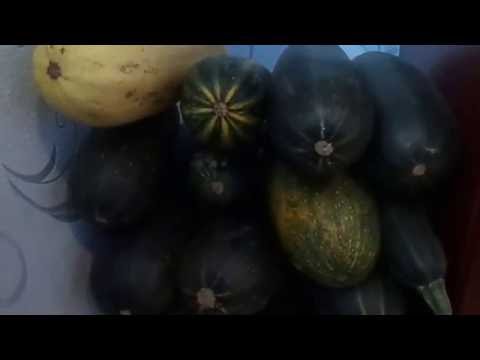

Watch this video on YouTube
Types and varieties of zucchini
All zucchini are divided into ordinary (white-fruited) and zucchini. In zucchini, the leaf plates are strongly dissected, they often have white spots near the veins; inexperienced gardeners can confuse them with signs of powdery mildew. Zucchini pumpkins can be colored green or yellow with varying intensity. For example, the following varieties are zucchini: Black handsome, Astoria, Aeronaut, Gray, Yellow-fruited, Kaserta, Marquis, Zebra, Tsukesha, Negritenek; and also hybrids: Jan, Golda, Vanyusha, Jade, Diamant, Defender, Candela and Masha. The following varieties belong to the white-fruited zucchini: Anchor, Rolik, Spaghetti, Belogor, Gribovsky 37; and also hybrids: Kavili and Sangrum.
Also, these plants are divided according to the shape of the bush into semi-shrub (with short lashes) and bush. The fruits can be round or oblong, but there are varieties with other forms of pumpkin.Zucchini are also divided according to the ripening period into early ripening, mid-ripening and late.
There is a very large number of varieties of this plant, as well as many hybrids, which, as a rule, only foreign specialists work on breeding. Such hybrids have their advantages, namely: the skin is not so thick, and the seed chamber is smaller than usual. In addition, the fruits can remain on the plant for a longer time without overripe, and their presentation is comparatively better. But experienced gardeners most often choose domestic varieties, since they have greater frost resistance, and their pumpkins are also excellent for conservation.
The most popular domestic and imported zucchini varieties:
- Aeronaut... This compact bush zucchini has a small number of lashes. Most of the flowers on the bush are female. Thin-skinned smooth cylindrical pumpkins are dark green in color, there is a greenish or white speck on their surface. The slightly sweet pulp is cream colored. This plant is very popular with gardeners, as it is high yielding. This variety is suitable for outdoor and greenhouse cultivation. The fruits can be used for canning and for preparing various dishes.
- White... This early ripening variety is notable for its productivity and unpretentiousness; it ripens in just 35-40 days. Medium-sized oval pumpkins are almost white in color. The pale creamy flesh is very juicy and firm. The fruits can be used for pickling, preservation, cooking and long-term storage.
- Yellow-fruited... This is a bushy early zucchini with a high yield, it is grown in the open field. Cylindrical slightly ribbed universal pumpkins are yellow. The composition of the fruit contains a large amount of carotene, so they are used to prepare dietary and baby food.
- Zebra... Compact bush early ripe zucchini, characterized by frost resistance, has a short main stem. Cylindrical pumpkins are greenish in color, on their surface there are wide stripes of dark green color, which are located longitudinally. Not very sweet juicy pulp has a light yellow color. This variety is one of the most productive, while its fruits can be used both for conservation and for cooking.
- Sangrum... This early maturing bush hybrid is intended for open field cultivation. Green and white cylindrical pumpkins are high in sugar.
- Helena... This bush variety is early maturing and single-leafed. Cylindrical smooth pumpkins have an even golden color. The pulp is yellow. The fruits can be used for preservation, pickling and cooking.
- Black handsome... This compact bush zucchini variety with a high yield is intended for cultivation in the open field. It bears fruit for a relatively long time. Fruits have a dark green almost black color. The firm and white flesh is savory and tender. The fruits are suitable for preservation and cooking.
- Negro... This early ripening variety of zucchini has a high yield and resistance to powdery mildew, it is intended for cultivation in the open field. Pumpkins have a green-black color, their flesh is tasty and juicy green.
- Kavili... This ultra-early bush hybrid has a very high yield, a long fruiting period and resistance to powdery mildew. Cylindrical straight pumpkins are pale green, the taste of white pulp is delicate. It can be cultivated both in the greenhouse and in the open field.
- Kuand... These semi-shrub and bush zucchini of medium ripening, are distinguished by high productivity and resistance to rot and powdery mildew. They can be cultivated in greenhouses and outdoors.There are intermittent stripes on the surface of cylindrical greenish pumpkins.
- Gribovskiy 37... A medium-ripening highly branching variety is intended for open field cultivation. Short-cylindrical greenish pumpkins, ribbed in the region of the stalk. The fruits are covered with a tough crust. This variety of universal use has been cultivated by gardeners for a very long time.
- Spaghetti squash group... In these varieties, the fruits are extremely unusual. If you cook a whole zucchini for 30 minutes, then its pulp will become a dish consisting of thin dense flagella, which are similar to Italian pasta. The most popular variety is Raviolo, whose cylindrical pumpkins are yellow in color.
The greatest decorativeness is possessed by such varieties as Zheltoplodny, Yellow banana, Zolotinka, Golden, Miracle orange, Zebra, Winter delicatessen, Tapir, and also the Zephyr and Festivalnaya hybrids. The color of pumpkins in such plants is highly decorative, which will be a good decoration for your site. Those who prefer fruits that are not quite usual in shape should pay attention to the varieties Pear-shaped, Mystery club-shaped, and also to forms with round pumpkins Ball, Mother-in-law, Tintoretto, Ronde de Nice, as well as hybrids Khlebosolnaya, Povarikha, and Boatswain. Round pumpkins of the Watermelon variety are very similar to real watermelons. In the Amazing Giant variety, the fruits can be up to 100 cm long, while they weigh up to 10 kilograms, and they can be stored for 2 years. In the variety Two-color miracle, zucchini are painted in 2 colors at once, with a distinct border between them. In the Ascending variety, the fruits have a very interesting shape, it may seem that they were created by a skilled sculptor.
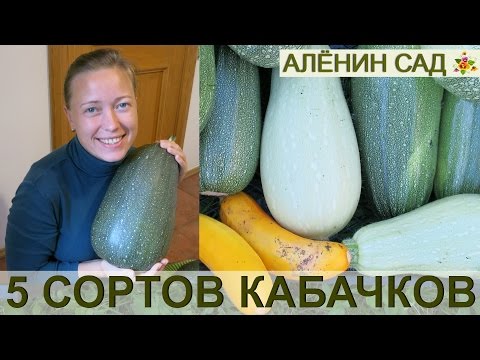

Watch this video on YouTube



